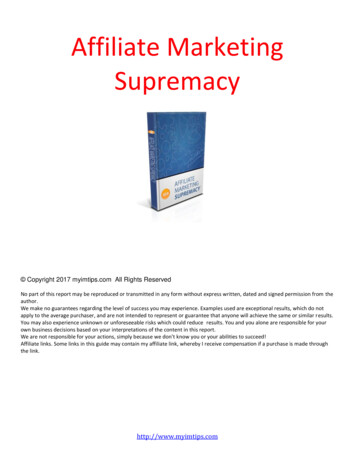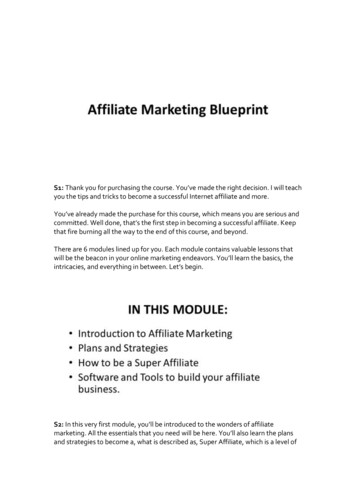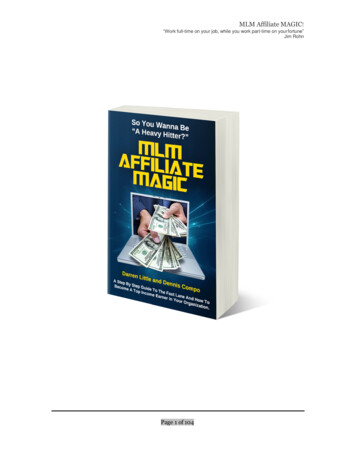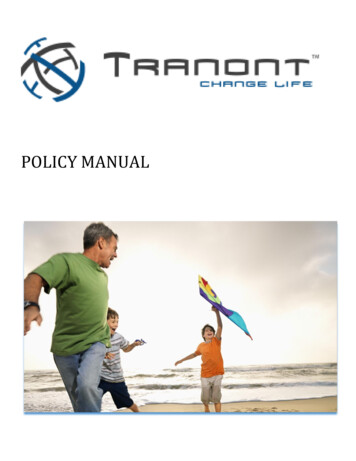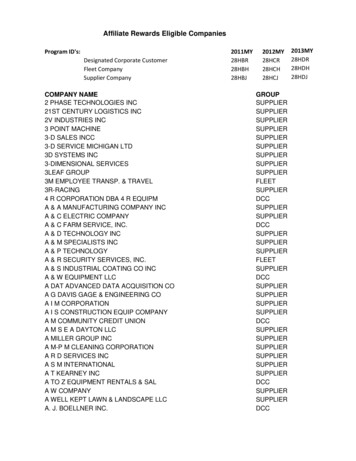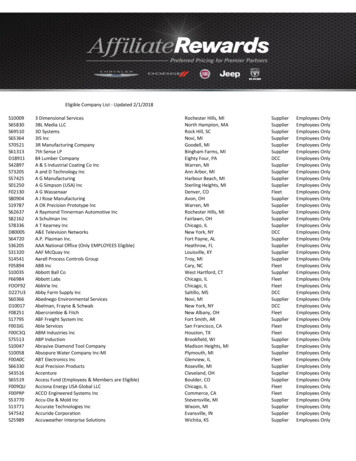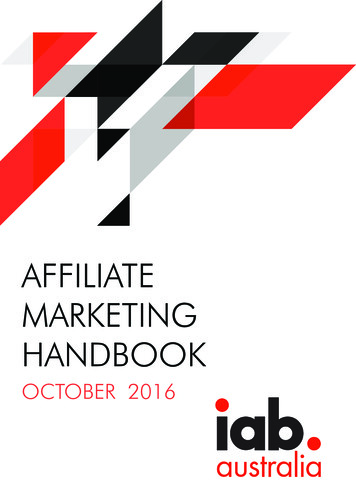
Transcription
AFFILIATEMARKETINGHANDBOOKOCTOBER 2016
The 2016 Affiliate Marketing Handbook was compiled by the IAB Affiliate MarketingWorking Group.Members of the IAB Affiliate Marketing Working Group:Anthony CapanoRakuten MarketingChris GarnerCashrewardsIsabell SchneiderMediaComMatthew SheppardNavigate DigitalRicha DaniColumbusRoger LeeAPDVerity BeardAllure MediaZane McIntyreCommission Factory
IAB Affiliate Marketing Working Group member companies:APD is a full service, 360 degree digital marketing agency. Affiliate has always been one of the core services that weoffer, having brought the industry to Australia in the early 2000’s as dgm. We now have offices in Sydney, Melbourneand around the APAC region. We believe in working collaboratively and openly with our advertisers to developtheir digital strategies and achieve their digital goals. Our premium Affiliate Network uses state of the art trackingtechnology and allows our advertisers to partner with Australia’s top Affiliate Publishers.Allure Media is one of the fastest growing digital publishers in Australia. We partner with some of the world’s largestand most innovative publishing partners to bring their brands to Australia. As brand custodians in this market, weare about fast-paced content produced by high profile local editors and distributed in a way that is fresh, relevantand actionable. The Allure Media team is responsible for the publication and continuous development of ten globalbrands in Australia, including the likes of POPSUGAR, ShopStyle, Business Insider and Gizmodo amongst others.Cashrewards is the fastest growing online shopping community in Australia and we are still in start up phase. Basedon the NAB online retail index, Cashrewards delivered 1.05% of all online retail spend in Australia in FY16 with over 210M in sales. We are now delivering 20M a month in sales for the largest brands including eBay, David Jones,Expedia, Coles, Woolworth’s. Our aim is to disrupt shopping in Australia and give over 2M Australians more cashrewards than any other loyalty site in the country.Columbus is a digital connections agency driven by a blend of performance and experience expertise underpinnedby data and technology. Our talented and passionate team partners with our clients to build meaningful connectionsbetween people, ideas, and brands. Our expert data navigation, pioneering strategy and exploration of emergingtechnology push us further to understand the customer journey and drive people’s behaviour; we create value forour clients. Since its inception in 2006, Columbus has been a pioneer in the Performance and Experience space,growing to become the largest agency in Australia in our field.Rakuten Marketing is the global leader in omnichannel marketing, delivering its vision of driving the omni experience– marketing designed for a streamlined customer experience. Offering an integrated strategy that combinesconsumer centric insights with e-commerce expertise, Rakuten Marketing’s omnichannel services include RakutenAffiliate Network (formerly LinkShare), Rakuten Display, and Rakuten Attribution. Operating as a division of RakutenInc. (4755: TOKYO), one of the world’s leading Internet service companies, Rakuten Marketing is headquarteredin New York City, with additional offices in Australia, Brazil, Japan, the United Kingdom, and throughout the UnitedStates. Follow us on LinkedIn or learn more at http://rakutenmarketing.com.au.MediaCom is the “The Content Connections Agency”, working on behalf of its clients to leverage theirbrands’ entire system of communications across paid, owned and earned channels to step change theirbusiness outcomes. MediaCom delivers not just individual channel silo efficiencies but also connectedcommunications system effectiveness, by developing and optimising all content – defined as any form ofconsumer messaging – as the fuel that drives high-performing systems. MediaCom measures and quantifiescommunications systems across paid, owned and earned through their unique Connected System Audit.Navigate Digital is an award winning, independent, experienced, straight talking and approachable performancemarketing agency. It employs a strategic approach that is bespoke to each of its clients, ensuring it creates innovativedigital media solutions that deliver tangible results.Commission Factory is one of the largest affiliate networks in APAC with over 400 retailers or service providers.Launching in 2011 as a startup within a local tech incubator Commission Factory was researched and developedby ex-Publishers and Advertisers that had a desire to disrupt the status quo of affiliate marketing and to be moreaccessible to a wider range of clients. From SME’s to large Enterprise clients, the platform lends itself to be as simpleor complex as you need it to be with new features and technology being added regularly.
CONTENTSContentsINTRODUCTION . 4WHAT IS AFFILIATE MARKETING? . 5HISTORY, KEY PLAYERS & CURRENT CHALLENGES . 7AFFILIATE TYPES . 10BEST PRACTICES FOR ADVERTISERS . 12CHOOSING YOUR AFFILIATE NETWORK . 14ROLE OF AFFILIATE MARKETING IN THE MARKETING MIX . 16KEEPING CONTENT ALIVE IN THE AFFILIATE CHANNEL . 18KEYS TO SUCCESS . 20CAPITALISING ON TECHNOLOGY . 22A MODERN MARKETPLACE . 25GLOSSARY . 28
INTRODUCTION“The Australian digital advertising and marketing ecosystem is growingand Affiliate Marketing is a key part of the value chain. AffiliateMarketing has outgrown its role as just another marketing channel andbecome an objective in its own right. Affiliate Marketing uses many ofthe same tools as the more traditional digital marketers - such as email,search, social, SEO and retargeting - and now is an integral part ofmany integrated marketing campaigns.Well managed and executed affiliate campaigns will help brandsthrive by driving efficient consumer acquisition. I know from my time atlastminute.com just how valuable Affiliate Marketing can be in drivingproduct sales. Yet it can do so much more for a brand: With the ubiquityof mobile devices and the continued rise of programmatic trading, it candeliver valuable audience- and consumer-data insights across multipleplatforms.Councils and Working Groups are the lifeblood of the IAB: Withrepresentation from some of the best minds in the industry, they are anunmatched repository of knowledge on all things digital. The AffiliateMarketing Working Group will help define this flourishing marketingdiscipline going forward by setting standards and best practiceguidelines to benefit the entire industry.This Handbook has been complied by the best in the industry to providean outline of the industry as it exists, the role of content and technologyand place of Affiliate Marketing in the modern digital marketplace.Vijay SolankiCEO, IAB Australia”
WHAT IS AFFILIATEMARKETING?ROGER LEEAPDIt’s a good question, and one with an everevolving answer. So let’s start at the beginningby trying to give it a simple definition:Affiliate Marketing is the practice whereby adigital publisher or website promotes an onlineretailer and earns a commission based on thesales or leads that the advertising generatesfor that online retailer.We term this payment metric CPA – Cost PerAction. Typically an ‘Action’ is a sale of anonline good or service, but it can also be alead or registration, a call, a download or anyother trackable action that is desired of theend customer. In recent years this has grownto even include offline sales — provided theycan be tracked back by a coupon or barcode.There are two ways the CPA are set:Flat rate: For every action a fixed fee is paid.This is typically used for registration typeactions with no cost, such as a credit cardsign-up or for a fixed price product like amobile phone contract.Revenue Share: The price of the itempurchased is tracked and a percentage ofthat price is then paid to the affiliate. This isgenerally favoured by advertisers selling arange of tangible goods at varying prices,such as fashion retailers.Affiliate Marketing is part of the performance5IAB AUSTRALIA AFFILIATE MARKETING HANDBOOKmarketing family, meaning the return oninvestment is guaranteed and the advertiser isonly paying for advertising that has succeeded.It’s a versatile channel and is very effective atdriving actions for merchants selling consumerproducts or services across a wide range ofverticals, including apparel, travel, electronics,health and beauty, telecommunications, financeand groceries. It should be considered as akey part of an advertiser’s marketing mix in anintegrated campaign, specialising in turningbrand awareness and interest into conversionstowards the end-of-purchase funnel.We use the terms ‘Affiliate’ or ‘Publisher’to define the website that is promoting thebrand or products. In later chapters we’lllook more in-depth at the business modelsthat affiliates employ to drive actions for theadvertiser. For now, let’s just dispel a commonmisconception: Affiliate Marketing isn’t justbanner advertising, in fact, most campaignswill get less than 10% of their sales as aresult of banner advertising. Consumershave learned to ignore these banners, sosuccessful affiliates employ smarter, moreengaging tactics to generate sales for theadvertisers they work with, with most salescoming from ‘text links’ often hidden behind‘Buy Now’ or ‘Shop Here’ type buttons. A ‘textLink’ in the affiliate world is just a trackableURL that redirects to the relevant page of theadvertiser’s website.Whilst the majority of affiliates still generateactions for their advertisers by promoting on
their own website or blog, there’s now manyother ways they generate customers. Thisincludes email marketing, mobile apps, paidsearch, remarketing widgets or campaigns,offline promotions and social campaigns. Thescope is almost unlimited. Any publisher orpartner paid to promote on a CPA metric couldbe considered an affiliate.How does it work technically?Most advertisers will employ an AffiliateNetwork to administer the tracking of theirAffiliate Campaign. The network will providea set of tracking links to the affiliates thatsit behind the banners and text links onthe affiliates’ websites. When the customerclicks on that link a cookie is dropped ontotheir computer and that click is registered bythe Affiliate Network. When that customerthen completes a purchase and reaches theadvertiser’s confirmation page, the AffiliateNetwork’s tracking tag is fired. That tagchecks for the relevant cookie and if thecustomer has come from one of the AffiliateNetwork’s publishers, the sale is recordedby the Affiliate Network in their platform. Viathat platform both the advertiser and affiliate1. Customer visits publisherwebsite2. Customer seesadvertising banner/linkand clicks through via anaffiliate tracking link. Thecustomer will likely notrealise they have used anaffiliate link3. The click is tracked bythe affiliate network anda cookie is placed on thecustomer’s device to identifythem as being referred byan affiliate network4. The customer completesan online purchase5. The advertiser fires theAffiliate Network’s trackingtag which reports the saleto the affiliate network asthere is a cookie present6. The Affiliate Networkreports the sale to theadvertiser and they pay theagreed commission for thatsale7. The Affiliate Networkpays the commission to thepublisher as a reward forgenerating the sale6IAB AUSTRALIA AFFILIATE MARKETING HANDBOOKshould be able to see that the sale hastracked and a commission can be awarded.The advertiser populates the tracking tagwith all of the information relevant to the sale,typically the price and order ID are alwaysincluded, then additional fields such theproduct stock keeping unit (SKU) or promotioncode can be added and tracked to assist withanalysis of the campaign’s performance.Again, there’s a wide range of complicationsand options to improve on the basic trackingmodel. The more advanced networks areable to provide cookie-less tracking, so thatsales can still be attributed to affiliates whenthe user has blocked or deleted the affiliatecookie. This is becoming increasinglyimportant as some browsers automaticallyblock third-party cookies. More complextracking can utilise unique promotionalcodes or block non-affiliate codes to recordsales. Affiliate tracking pixels can beconditionally fired to de-duplicate againstother traffic sources — though complexprogramming is needed around the rules forthis, given that cookie lengths are typicallymuch long than a single session.
HISTORY, KEY PLAYERS &CURRENT CHALLENGESAustralia’s development of Affiliate Marketing was initially based around self-serve platforms thataffiliates could access and gather the links they needed. Over the past five years these platformshave been usurped by the emergence of Affiliate Networks which were born in Australia, orimported and served by local teams. This approach now mirrors their equivalents in other markets.MATTHEW SHEPPARDNAVIGATE DIGITALAustralia’s development of Affiliate Marketingwas initially based around relatively simplisticself-serve platforms that affiliates couldaccess in order to gather the links theyneeded. This mirrored the early developmentof Affiliate Marketing in other markets.In the last decade these platforms havebeen overtaken by the emergence of moreadvanced Affiliate Networks. In Australiathese Affiliate Networks are a mixtureof locally owned businesses as well asinternational networks.As the market matures it would appearthat Australian programs are consolidatingto key players with local presence.Having feet on the ground is important tointernational retailers wishing to maximisetheir Australian Affiliate Marketing efforts. Inaddition to these networks, there has beenthe emergence of specialist performancemarketing platforms. These SaaS (Softwareas a Service) businesses have cementeda position with some of Australia’s largestretailers and perform a wide variety oftracking services beyond Affiliate Marketing.They offer a deep dive into consumer data7that is often beyond the typical requirementsof advertisers. This market structure nowmirrors their equivalents in mature marketslike the U.S. and U.K. The businessesinvolved are commonly seeing high double- oreven triple-digit growth.With the growth of Affiliate Network camethe rise of the Affiliate Agency in Australia.Agencies in Australia offer an objectivemanagement service to retailers helping themnegotiate what can be a noisy market place.Agencies should position their Affiliate Programamongst the often headline-grabbing digitalneighbours of Search and Display. It has beenreported that large agency groups are seeinggreater demand for these services from theirclients who lack the expert resource to managetheir own programs.Australian Affiliate Marketing has seen theemergence of technology vendors, like thosewho specialise in conversion optimisation,search and display retargeting. These firmshave seen great success in Europe and arereplicating it in Australia. This will be coveredin more detail in the Technology section (seepage 20).This work has led to the adoption of AffiliateIAB AUSTRALIA AFFILIATE MARKETING HANDBOOK
Marketing programs by some (but it has tobe said, not all) of Australia’s largest retailersand an ever-growing base of SMEs who areoften finding the performance model to becost effective means of meeting their businessobjectives.The diagram above shows many of the keyplayers in the market today and is broadlysplit between technology, strategy andmanagement services (the Industry) andsome of firms considered to be affilaites (thePublishers).The numbersThere is no unified or verified data on thevolume of Australian affiliates or their valueto retailers but it’s estimated that there areapproximately 3000-4000 active affiliates inAustralia. At present, there are no agreedfigures on the number of retailers at play inthe Australian market or the volume of clicks,transactions or revenue that the channeldrives. However, future collaboration by IABmembers aims to produce firm, audited figures.Global comparisonsGiven the approximate nature of our dataon the industry it is a little difficult to make8IAB AUSTRALIA AFFILIATE MARKETING HANDBOOKfirm comparisons to other markets. However,taking more mature markets, such as the U.K.and U.S., there are certainly comparisons thatcan be drawn: We see a strong community of bloggers andcontent creators utilising Affiliate Marketingto monetise their sites in both markets, yetAustralia is still developing strength and depthof individual, niche affiliates. As with the U.S. and U.K., incentive andcoupon sites are dominant due to the natureof their business models and in some cases,replication of sites and processes for theAustralian market. Key players in the market are activelybuilding the industry’s reputation in Australiathrough education, events and interaction withthe wider digital industry. It is clear that the largest retailers in theworld have embraced Affiliate Marketing.Taking U.K. broadband internet providersas an example: firms like Virgin, SKY andBT all invest heavily in the channel as anacquisition strategy. At the time of writing, thisapproach had yet to be replicated in Australiaby domestic equivalents. This comparison iseasily replicated through fashion, retail andinsurance.
As with other markets, Australian retailersenjoy the performance-led nature ofthe industry and its focus on ROI andtransparency.9IAB AUSTRALIA AFFILIATE MARKETING HANDBOOK Technology platforms work on aperformance basis in order to lessen therisk of a proposition for retailers across mostmarkets.
AFFILIATE TYPESWhen we talk about Affiliate Marketing, it is important to note that there are different types ofaffiliates. The method chosen by the affiliate to promote the advertisers’ products is the keydifferentiation. Each affiliate type fulfills a different role in terms of value, volume and reach. Byunderstanding affiliates on an individual basis, advertisers will have the knowledge of who is bestpositioned to deliver in certain industries or to promote particular products.ISABELL SCHNEIDERMEDIACOMReward sitesWith online shoppers becoming increasinglysavvy, reward sites have seen a surge inpopularity. This type of affiliate drives salesby rewarding its members through a share ofthe commission it earns from an advertiser.If provided with a competitive offer, rewardsites can generate significant volume. Theyprovide brands with an effective way toincrease its exposure, especially if productsare not strongly positioned on aggregatorsites. If used strategically, reward websitescan drive incremental growth (e.g. rewardto increase average order value, highercommission for purchase of new customers).It is important to have a sophisticatedvalidation process in place in order to avoidpaying commissions on cancelled bookingsor return purchases.Content sites and blogsThese types of websites are often focused ona niche interest and feature unique content.A few examples are product review sites,blogs and online forums. Often, Content10IAB AUSTRALIA AFFILIATE MARKETING HANDBOOKAffiliates form part of an Affiliate Program’slong-tail strategy and are rarely large volumedrivers. Regardless of their contribution tooverall sales, they are valued partners. Thereason for this is that unique content suggestseditorial credibility and often has a positiveimpact on an advertiser’s search engineoptimization (SEO) efforts.Content sites can also help reach a newaudience. This audience might not necessarilybe looking for your brand in particular butcould come across it through a feature ina newsletter as the affiliate reaches anaudience that is actively looking for the topicaround your brand. A great way to engageand optimise activity with content sites is byproviding fresh content or an exclusive offer.Recently we have also seen an increase inintegrated content pieces as well as affiliateswho are using video to monetise a product.EmailAn Email Affiliate sends targeted emails toits own (or third-party) data base to driveconversions on behalf of a brand. In orderto drive volume, a strong and time-sensitiveoffer is required and creative should berefreshed regularly. It is important to alwaysconsider the size and source of the data to
ensure it is compliant with local and brandregulations and to avoid over promotion ordatabase exhaustion.Comparison websitesThese sites offer consumers the opportunityto compare products of different advertisers(like credit cards or phone plans). Through acompelling offer, comparison websites cangenerate large sales volumes. They vary a loton how they structure their rankings, which isnot always based on best product but oftenearnings per click (EPC).Retargeting AffiliatesAffiliates retarget most commonly throughtags that they place on the advertiser’ssite and try to re-engage with consumerswho have not completed their purchase.This could either be via an overlay when aconsumer is about to leave a website, tryingto persuade them to stay, or via email if theyhave abandoned their shopping cart, makingit easy for them to return and to completetheir purchase. The advertiser has full controlover traffic source and targeting options. Itis recommended to trial different creativeand messages and not to rely too heavily onhanding out incentives.PPC AffiliateA PPC (pay-per-click) Affiliate is a searchspecialist who drives traffic to an advertiser’ssite by bidding on relevant keywords via acustom-built landing page. They generally11IAB AUSTRALIA AFFILIATE MARKETING HANDBOOKwork on a CPA basis but sometimes requirehybrid commercial agreements. PPC Affiliatesare not for every client but can be greatstrategic partners if: Competitors are cannibalising advertisers’ads Limited budgets don’t allow for an ‘alwayson’ approach, leading to lost exposure Aggregator ads are appearing onadvertisers’ search terms and directing brandtraffic to competitor productsThe key to a successful trial with a PPCAffiliate is to set up strict guidelines which helpensure affiliates are compliant.Voucher and deal sitesThese type of sites generate sales by offeringtheir users a discount code that can beredeemed online against their purchase.They also often promote generic deals in adesignated section. An exclusive code willusually increase exposure on the site, wherea quick expiry date will create a sense ofurgency for consumers and can be used as astrategic tool to drive quick sales.Social AffiliatesThis type of affiliate works via highly targetedposts on social networks or sponsoredtweets, which can help to drive awarenessand assist in generating need. It is importantto keep the creative relevant, with a strongcall to action.
BEST PRACTICES FORADVERTISERSROGER LEEAPDAn advertiser should consider their affiliatesas an extension of their sales force. Therefore,to run an effective affiliate campaign, theyneed to motivate their affiliates appropriatelyand give them the tools that they need topromote their brand and products. As anadvertiser you should consider it a partnershipwhere you both have the same goal:Generating sales of your products. These arethe key things to consider when structuringand running an affiliate campaign:CommissionThis is a key component of any campaign,it’s the main driver in motivating affiliates topromote your brand. It’s set by the advertiserso it could be tempting to go really low. Beaware though, that any decent affiliate isgoing to choose to promote your competitorsover you if they have better payouts. A moregenerous payout will give you access to betterexposure and increase the incrementality ofthe sales that you receive. Equally, commissionshould be set a profitable rate where theROI on every sale is positive. Be tacticalwith commission and offer higher rewardsto affiliates based on their business model.Offer short-term increases to spike sales atkey periods. Every item you sell should becommissionable, even if it’s at a lower rate.Always onAn effective Affiliate Marketing campaign12IAB AUSTRALIA AFFILIATE MARKETING HANDBOOKshould always be in market. As an advertiseryou’re asking affiliates to write content aboutyour store and/or products. They will be a lotmore inclined to put in the work to promoteyou if they’re confident that after building thatcontent they will continue to be rewardedfor that effort. This also means having anunlimited budget, so view your AffiliateMarketing spend as a sales cost rather than atraditional marketing budget. For every dollaryou spend on Affiliate Marketing you shouldbe getting multiple dollars back in return so itshould never make sense to turn it off.Track and analyse everythingTrack in real time and give your affiliates asmuch visibility as possible across what’s selling.If they know which products they’re selling themost of, they can tailor content accordingly.Get reports on the devices your customers areshopping on, know which ‘promocodes’ havebeen successful, review which creatives workedand which didn’t. Understand which affiliatesare generating sales for you and understandwhy. It’s also key that tracking is accurate —don’t track in the wrong currency or expect tomanually remove delivery costs later on. It’sabsolutely vital that your tracking is accurateand never removed or broken.CommunicateIf you don’t talk to your affiliates they won’tknow how best to promote your brand.Provide them with your unique sellingpropositions (USPs) and key messages.Give them advance notice of sales and new
product launches. However don’t take this aslicence to spam them with new offers threetimes a day or they will switch off.Validate fairlyMost Affiliate Networks will ask you to validatethe sales they have tracked at the end of eachmonth to allow you to avoid paying for anyfraudulently generated sales or incompletesales. If you are de-duplicating against othermarketing channels it should be made clearin advance and should not include naturalsearch or paid search on brand terms as othermarketing channels — these customers arejust trying to navigate back to your websiteafter being introduced by an affiliate. Againthis influences the affiliate’s motivation, if theysee a high rejection rate on your campaign,they’ll choose to promote a different advertiserinstead. It’s also highly important to validatesales in a timely manner so that the affiliatescan be paid.Promotional CreativeWhilst banners aren’t the most effective formof affiliate advertising they still help, especiallywith coverage for key promotions. Understandthe popular sizes that your affiliates need andprovide them in advance.StrategyAffiliate models are diverse, consider eachone individually and work with your affiliatenetwork to build an ongoing strategy for eachto give them what they need. Run tailoredpromotions with Coupon Affiliates, providecontent to your Content Affiliates, provide anaccurate and clean product feed to your pricecomparison partners, schedule promotionswith Cashback and Loyalty partners, leverageseasonal events etc.Beyond salesThink about how else you can use youraffiliates beyond purely generating sales.Using affiliates to build a newsletter databaseis common. You can also use affiliatestactically to increase your average basket13IAB AUSTRALIA AFFILIATE MARKETING HANDBOOKvalue, to encourage customers to downloadyour app or shop via their mobile. Againcreate a strategy for each goal you wish toachieve and track performance. Offering anattractive reward to affiliates for encouragingcertain customer actions will help withsuccess.Avoid fraud and affiliatemalpracticeVery occasionally an affiliate may try togenerate sales fraudulently or members ofcashback and loyalty sites will try to exploit aloophole. With tight program rules and vigilantmonitoring it should be easy to identify thisactivity and avoid paying for these sales. Havevery clear rules in place around brand biddingand how your brand is to be advertised.Most Affiliate Networks will have tools andprocesses to monitor the space and flag anyuntoward activity so that you are not chargedfor it. Sense check anything that looksodd with your Affiliate Network so that youunderstand what is actually happening andthe value of that activity. With particular viewto cashback and loyalty sites: Don’t pay outfor large sales that could be later cancelled— like holidays — and don’t pay out more incommission than the customer is required tospend to qualify for the commission — suchas a betting campaign paying 100 for a 10deposit.Be ResponsiveAffiliate Marketing is a team effort betweenthe advertiser, the network and affiliates. Itrequires constant attention and input to workeffectively. Like any marketing campaign, youcan’t set and forget, then expect good resultsand growth.EvolveThe affiliate space is always changing,there are always new opportunities and newchallenges to what worked last year. Keeplearning, keep analysing what your affiliatesare doing for you and keep trialling new waysof generating sales via the channel.
CHOOSING YOURAFFILIATE NETWORKZANE McINTYRECOMMISSION FACTORYWhether you are new to Affiliate Marketingor have lots of experience in the channel italways pays to weigh up the options betweendifferent Affiliate Networks and their strengths.Armed with the knowledge of some of theNetwork variables and what that means toyour margins and ROI’s makes an enormousdifference to the potential of your program.The benefits of Affiliate Marketing are many butnone so great as the ability to pay commissionto publishers based purely on performance.This alleviates the risk that if the traffic doesn’tconvert to sales you’re not still being charged forthe click or impression and the transparency ofthe ROI with the ability to track the sales origin.The reason networks are widely used byadvertisers can be likened to any other formof business outsourcing where individualsoperating alone can achieve larger economiesof scale. Additionally networks offer extend
– marketing designed for a streamlined customer experience. Offering an integrated strategy that combines consumer centric insights with e-commerce expertise, Rakuten Marketing’s omnichannel services include Rakuten Affiliate Network (formerly LinkShare), Rakuten Display, an
